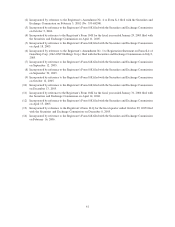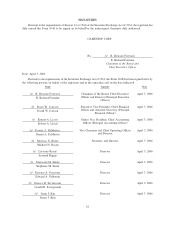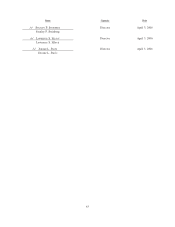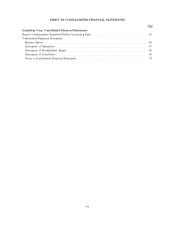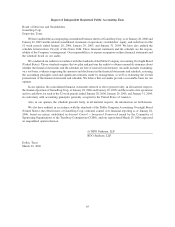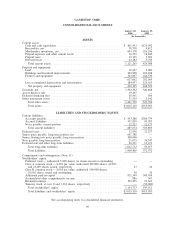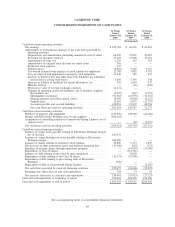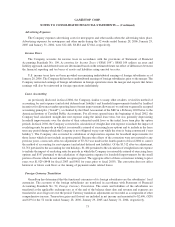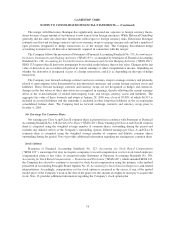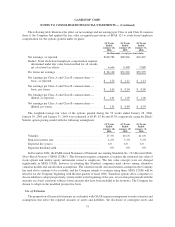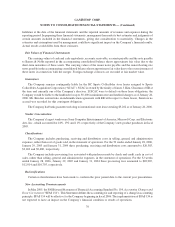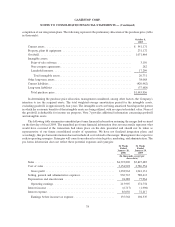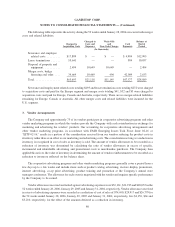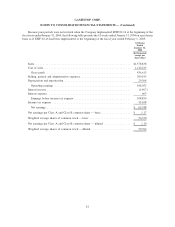GameStop 2005 Annual Report Download - page 80
Download and view the complete annual report
Please find page 80 of the 2005 GameStop annual report below. You can navigate through the pages in the report by either clicking on the pages listed below, or by using the keyword search tool below to find specific information within the annual report.Year-End
The Company’s fiscal year is composed of the 52 or 53 weeks ending on the Saturday closest to the last day of
January. Fiscal 2005 consisted of the 52 weeks ending on January 28, 2006. Fiscal 2004 consisted of the 52 weeks
ending on January 29, 2005. Fiscal 2003 consisted of the 52 weeks ending on January 31, 2004. Fiscal 2006 will
consist of the 53 weeks ending on February 3, 2007.
Cash and Cash Equivalents
The Company considers all short-term, highly-liquid instruments purchased with an original maturity of three
months or less to be cash equivalents. The Company’s cash and cash equivalents are carried at cost, which
approximates market value, and consist primarily of time deposits, commercial paper and money market investment
accounts.
Merchandise Inventories
Our merchandise inventories are carried at the lower of cost or market using the average cost method. Used
video game products traded in by customers are recorded as inventory at the amount of the store credit given to the
customer. In valuing inventory, management is required to make assumptions regarding the necessity of reserves
required to value potentially obsolete or over-valued items at the lower of cost or market. Management considers
quantities on hand, recent sales, potential price protections and returns to vendors, among other factors, when
making these assumptions. Inventory reserves as of January 28, 2006 and January 29, 2005 were $53,277 and
$14,804, respectively.
Property and Equipment
Property and equipment are carried at cost less accumulated depreciation and amortization. Depreciation on
furniture, fixtures and equipment is computed using the straight-line method over estimated useful lives (ranging
from two to eight years). Maintenance and repairs are expensed as incurred, while betterments and major
remodeling costs are capitalized. Leasehold improvements are capitalized and amortized over the shorter of their
estimated useful lives or the terms of the respective leases, including option periods in which the exercise of the
option is reasonably assured (generally ranging from three to ten years). Costs incurred in purchasing management
information systems are capitalized and included in property and equipment; these costs are amortized over their
estimated useful lives from the date the systems become operational.
The Company periodically reviews its property and equipment when events or changes in circumstances
indicate that their carrying amounts may not be recoverable or their depreciation or amortization periods should be
accelerated. The Company assesses recoverability based on several factors, including management’s intention with
respect to its stores and those stores’ projected undiscounted cash flows. An impairment loss would be recognized
for the amount by which the carrying amount of the assets exceeds the present value of their projected cash flows.
As a result of the merger and an analysis of assets to be abandoned, the Company impaired retail store assets totaling
$9,016 in its United States operating segment. Write-downs incurred by the Company through January 28, 2006
which were not related to the merger have not been material. Note 2 provides additional information concerning the
merger.
Goodwill
Goodwill, aggregating $340.0 million was recorded in the acquisition of Funco in 2000 and through the
application of “push-down” accounting in accordance with SAB 54 in connection with the acquisition of Babbage’s
in 1999 by a subsidiary of Barnes & Noble. Goodwill in the amount of $2.9 million was recorded in connection with
the acquisition of Gamesworld Group Limited in 2003. Goodwill in the amount of $1,071.5 million was recorded in
71
GAMESTOP CORP.
NOTES TO CONSOLIDATED FINANCIAL STATEMENTS — (Continued)


